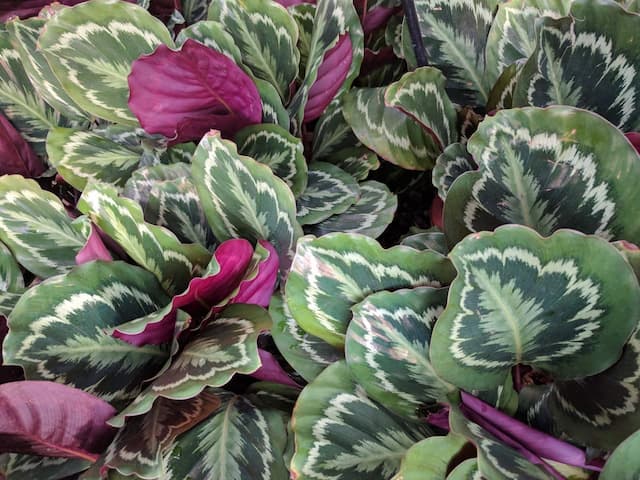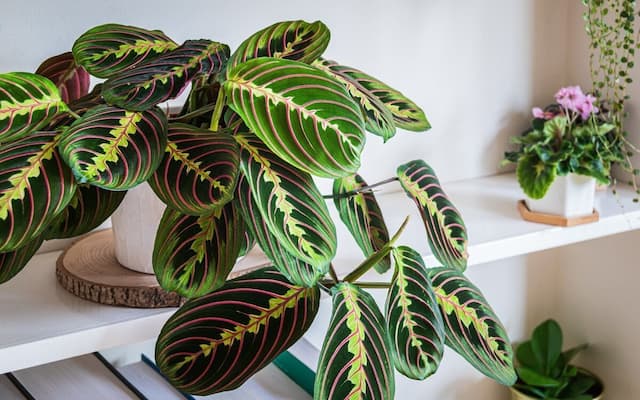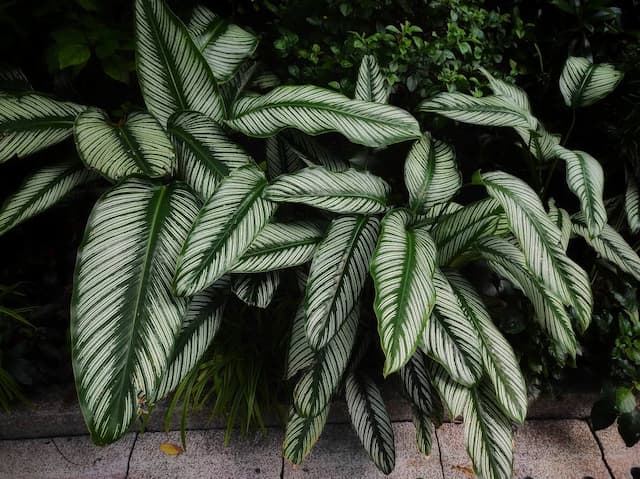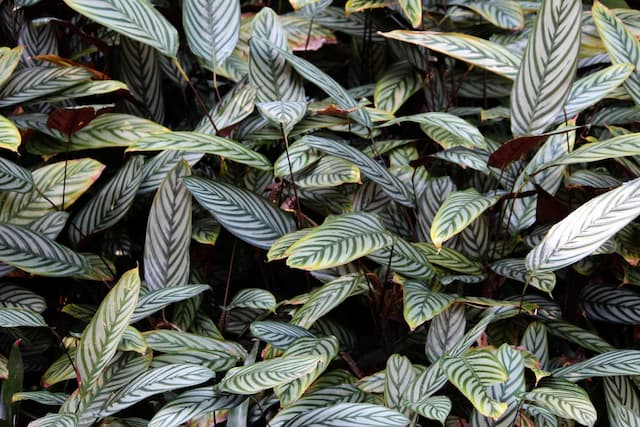Eternal Flame Goeppertia crocata 'Tassmania'
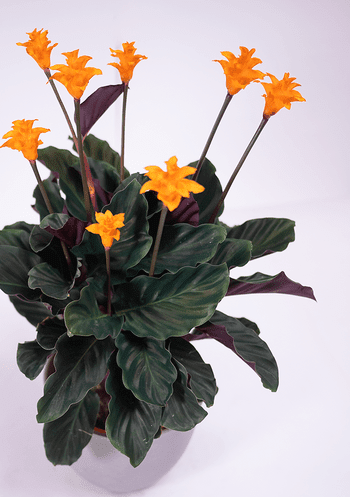
ABOUT
The plant with the common name Eternal Flame is characterized by its striking foliage that immediately draws attention. It showcases a flamboyant array of colors that truly live up to its name, boasting rich, deep green leaves that create a lush backdrop. The standout feature of this plant, however, is the underbelly of its leaves which reveal a stunning rusty, orange-red shade, providing a vivid contrast that resembles flickering flames. The leaves themselves possess an elegant, elongated shape that gracefully arcs, with edges that gently ripple, adding an element of softness and refinement to the plant's overall appearance. The Eternal Flame plant can impart a tropical ambiance to any setting, emulating the sensation of warmth and vibrancy that is often associated with its fiery colors and relaxed growth pattern.
About this plant
 Names
NamesFamily
Marantaceae
Synonyms
Eternal Flame, Fire Flash, Tassmania, Siamese Aglaonema
Common names
Calathea crocata, Goeppertia crocata.
 Toxicity
ToxicityTo humans
The Goeppertia crocata 'Tassmania', commonly known as the Eternal Flame plant, is not known to be toxic to humans. Therefore, accidental ingestion should not cause any serious symptoms of poisoning. However, it is always best to keep plants out of reach of children and to avoid ingesting plant material that is not confirmed to be safe.
To pets
The Eternal Flame plant (Goeppertia crocata 'Tassmania') is not toxic to pets. It is not known to cause any serious symptoms of poisoning in animals such as dogs and cats if they accidentally ingest parts of the plant. Nevertheless, it is still advisable to prevent pets from chewing on houseplants, as they could still cause gastrointestinal discomfort or more severe issues due to the physical properties of the plant material or if the plant has been treated with pesticides or other chemicals.
 Characteristics
CharacteristicsLife cycle
Perennials
Foliage type
Evergreen
Color of leaves
Green
Flower color
Orange
Height
2-3 feet (60-90 cm)
Spread
2 feet (60 cm)
Plant type
Herb
Hardiness zones
10
Native area
South America
Benefits
 General Benefits
General Benefits- Aesthetic Appeal: The plant features attractive foliage with dark green leaves and striking orange undersides that can add a splash of vibrant color to indoor spaces.
- Ease of Care: It is relatively easy to care for, making it a good choice for both experienced and novice plant owners.
- Humidity Tolerance: It can tolerate higher humidity levels, which can be beneficial in homes with dry air, especially during winter months.
- Non-toxic to Pets: It is non-toxic to cats and dogs, making it a safe addition to households with pets.
- Adaptability: The plant can adapt well to various indoor environments, including offices and homes with limited natural light.
- Longevity: With proper care, it can be a long-lived plant, providing enjoyment for many years.
- Personal Wellbeing: Tending to plants like the Eternal Flame plant can provide psychological benefits, like reduced stress and an increased sense of wellbeing.
 Medical Properties
Medical PropertiesThis plant is not used for medical purposes.
 Air-purifying Qualities
Air-purifying QualitiesThis plant is not specifically known for air purifying qualities.
 Other Uses
Other Uses- Goeppertia crocata 'Tassmania', commonly known as the Eternal Flame Plant, can be used in terrariums or vivariums, providing a tropical look and creating a micro-environment for small reptiles and amphibians.
- In photography, the unique foliage of the Eternal Flame Plant can serve as an exotic backdrop for macro or still life photography, adding depth and interest to the composition.
- As a natural art medium, the leaves of the Eternal Flame Plant can be used in eco-printing, a process where plant materials are used to transfer colors and patterns onto fabric or paper.
- The stems of the Eternal Flame Plant, when dried, can be used in creating natural jewelry or incorporated into mixed media art installations due to their interesting texture and form.
- The Eternal Flame Plant can be employed as a living mulch in tropical garden settings, helping to retain soil moisture and suppress weed growth under larger plants.
- Educational tools for children can be crafted from the Eternal Flame Plant, such as simple plant anatomy demonstrations, where kids can learn about leaf structure and plant care.
- During certain festivals or cultural events, the Eternal Flame Plant's vibrant leaves can be used for decorative garlands or table centerpieces.
- The plant can be used in color therapy or chromotherapy spaces; its bright orange flowers may contribute to an environment designed to energize and uplift moods.
- As a natural dye, the flowers of the Eternal Flame Plant may be used to create a range of yellow to orange hues for fabric dyeing or artistic purposes.
- The Eternal Flame Plant can have a role in sensory gardens, with its soft leaves providing a tactile experience and its bright flowers offering visual stimulation.
Interesting Facts
 Feng Shui
Feng ShuiThe Eternal Flame Plant, with its vibrant red flowers, is believed to add a strong element of fire energy to a space. In Feng Shui, placing the Eternal Flame Plant in the fame and reputation quadrant of a room or the south section of a home or office is considered to enhance one's public image and attract recognition and accolades.
 Zodiac Sign Compitability
Zodiac Sign CompitabilityThe Eternal Flame Plant is not used in astrology practice.
 Plant Symbolism
Plant Symbolism- Elegance: The Goeppertia crocata 'Tassmania', commonly known as the Eternal Flame, has lush, glossy foliage with orange flowers that exude sophistication.
- Endurance: The name Eternal Flame hints at the plant's symbol of long-lasting life and vigor, often representing enduring affection or perseverance.
- Warmth: With its fiery blooms, the Eternal Flame plant symbolizes warmth and positive energy, reminiscent of a comforting and nurturing presence.
- Passion: The colors and vivacity of the Eternal Flame are frequently associated with passion and strong emotions.
 Water
WaterThe Eternal Flame Plant prefers to be watered when the top inch of soil feels dry to the touch, which is typically once a week, but may vary depending on environmental conditions. Use room temperature water and gently pour it around the base of the plant until it begins to drain from the bottom of the pot, which is usually around 16-24 ounces for a medium-sized pot. During the winter months, reduce the frequency of watering to every other week or less, depending on the dryness of the soil, as the plant's growth slows down and it requires less water.
 Light
LightThe Eternal Flame Plant thrives best in bright, indirect light, avoiding direct sunlight which can scorch its leaves. A north or east-facing window is ideal, or a spot that is several feet away from a south or west-facing window covered by a sheer curtain to diffuse the bright light.
 Temperature
TemperatureThe Eternal Flame Plant prefers consistently warm temperatures, ideally between 65°F and 80°F, and should be protected from temperatures below 60°F, which can harm the plant. The plant does not tolerate cold drafts or sudden temperature changes well, so a steady indoor environment is best.
 Pruning
PruningPruning the Eternal Flame Plant is primarily done to remove dead or yellowing leaves to maintain its aesthetic appeal and to encourage healthy growth. Trimming should be done using clean scissors or shears, cutting just above the leaf node. The best time to prune is in the spring or early summer, which is the plant's active growing period.
 Cleaning
CleaningAs needed
 Soil
SoilEternal Flame Plant prefers a well-draining soil mix consisting of two parts peat or coco coir, one part perlite, and one part potting soil, with a slightly acidic to neutral pH of 6.0 to 7.0.
 Repotting
RepottingEternal Flame Plant should be repotted every two years to ensure fresh soil and root health; more frequent repotting may be needed if it outgrows its pot quickly.
 Humidity & Misting
Humidity & MistingEternal Flame Plant thrives best in high humidity levels, ideally between 60% to 80%, but it can tolerate lower humidity if necessary.
 Suitable locations
Suitable locationsIndoor
Keep in bright, indirect light and away from drafts.
Outdoor
Shelter in shade, protect from extreme weather.
Hardiness zone
11-12 USDA
 Life cycle
Life cycleThe life of the Eternal Flame Plant (Goeppertia crocata 'Tassmania') begins with seed germination in warm, moist soil conditions, which can be infrequent due to its common propagation by division. After germination or separation from a parent plant, the seedling or clone enters a growth phase, developing its distinctive foliage – green leaves with a purple underside. As the plant matures, it develops a strong root system and may produce offshoots or “pups” at its base, which can be separated for propagation. The Eternal Flame Plant typically blooms in its mature stage, presenting orange flowers that contrast with the foliage, although blooming is rare in indoor cultivation. After flowering, if conditions are not ideal, the plant may enter a period of dormancy, where growth slows or ceases until conditions improve. Throughout its life, the plant undergoes continuous cycles of foliage development and, when healthily maintained, can live for many years as a perennial houseplant.
 Propogation
PropogationPropogation time
Spring-Early Summer
The Goeppertia crocata 'Tassmania', commonly known as the Eternal Flame Plant, is typically propagated through division. The best time to propagate this plant is during spring, when active growth resumes. To propagate by division, carefully remove the plant from its pot and gently separate the root ball into smaller sections, ensuring that each new section has a healthy piece of rhizome and several leaves. Pot each new section in a container with a well-draining potting mix and maintain adequate moisture levels without waterlogging the soil. New growth will typically emerge after 2-4 weeks, indicating successful propagation.
